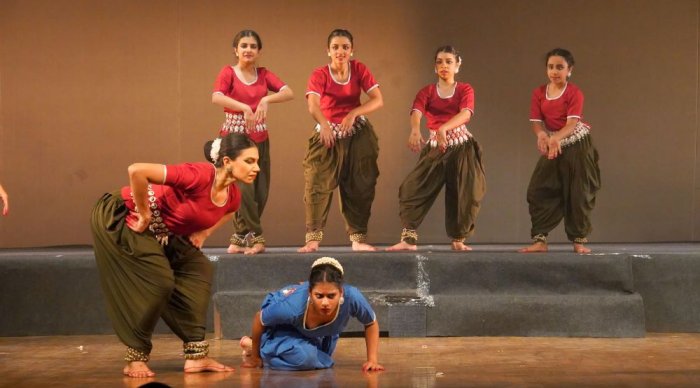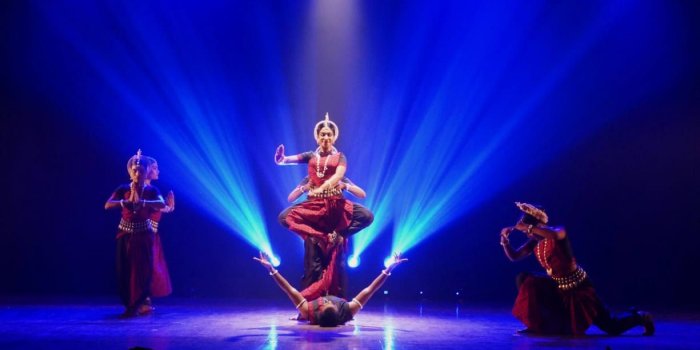
|   |

|   |
Odissi in assorted colors - Padmaja Suresh e-mail: padmajasuresh@hotmail.com Photos: RN Sudhi April 22, 2024 Students from Odissi Dance Center, Bangalore, now in its sixteenth year, under the able tutelage of Devjani Sen, performed with commitment on the 14th of April, in honour of Guru Kelucharan Mohapatra. It happened to coincide with the 20th death anniversary of this legendary Natya Acharya. Among traditional Odissi dance pieces, the repertoire included an ode to Lord Hanuman by the venerable Rama Bhakt Tulsidas - the 'Chalisa', and an innovative theme on the magnum opus of Rudyard Kipling, 'The Jungle Book'. Both of these had a special charm under the choreography of Devjani Sen. The dainty little dancers, accompanied by older but practically new students performed Mangalacharan - Namami, which was a prayer to Lord Jagannath, followed by an invocation to Lord Ganesha. A familiar Pallavi was rendered next by yet another group of students, with zeal and synchronicity. Chowka (square) and Tribhanga (body bent in one direction at the knees, the other at the hips and then the third arched at the shoulders and neck) being the main postures, the senior students had prepared the juniors to showcase the primary elements in this dance form. It is believed to directly connect with the stance of the Lord himself. It is understood that the lower half of the body (Pada) has to be stable, while the upper part (Hasta) is lyrical and fluid, the blend giving Odissi a unique identity.The head gear or Tahiya is representative of the Shikhara (tower) of the Jagannath temple, almost synonymous with Odisha. The Natya Shastra says that Saushthava is most important for drama or dance. When the waist and the ears as well as the elbow, the shoulder and the head are in their natural position (sama) and the chest is raised, the back absolutely well erect, it is called the 'Saushthava'. With some more attention to these areas, the budding students will go a long way in excellence. It was a soothing experience to soak in, with the priceless choreography of Guru Kelubabu and the music of Pandit Bhubaneswar Misra.  Hanuman Chalisa Senior students performed Hanuman Chalisa, set to Ragamalika and Talamalika. Music composition by Sukanta Kumar Kundu amalgamated various instruments suitably to enhance the vigour and verve of the 'Das' Hanuman, in executing his Lord's command as his loyal servant and emissary. Some of the poses emulated sculpture and painting imaginatively. Kudos to the entire team. Jungle Book that was presented as the last choreography, seems to be selected because of its wide acceptance as an evergreen tale, besides the creative scope for artistes. Music score was by Annada Prasanna Pattanaik, who ensured that it was both reminiscent of the movie, and simultaneously offered space to Odissi tradition. The 'Monkey chase' music was riveting while the Colonel Hathi March took us to the talkies, with stark similarity. The costumes were experimented upon, to suit the form of Odissi and bear resemblance to nature and aspects of the character played, be it either temperament or movement. Both the child Mowgli and the teenager with animals, portrayed in an anthropomorphic manner, especially made the fable enjoyable. Akshata as Bagheera, Ranjini and Ushna Kuri as Mowgli, Akshita as father Wolf, Anavi as Kaa, Debapriya as Colonel Haathi, Sohini as Baloo, Amrita as King Louie, Aditi as Sher Khan, Aahana as Shanti, the village belle and all others seem to have done their Guru proud.  Jungle Book Thereafter came the ensemble Srjan, the brainchild of Guru Ratikant Mohapatra, who as a dedicated son, is carrying on the indelible legacy of his illustrious father. Known to be an excellent mardala player, Ratikant as a master choreographer, presented his team of dancers with great panache. Srjan is well-known for fast-paced movements, innovative depiction of popular themes and improvised movements from the Natya Shastra, while staying within the framework of Odissi dance. The grandeur of their Guru Parampara remains unscathed in the annals of time. The virtuosity of the repertory once again corroborated the joint application of choreography, music, dance and technical effects with light design to augment the concept and its exposition. Srjan performed 'Adviteeyam', which literally means 'without a second' and the philosophical import of this would be that the Parabrahman is One and only One. Keeping the antiquity untampered, the dances gave a new dimension through a bouquet of the 'neo-classical' that not only highlighted the perspective but also respected the integrity of inheritance. The individual dance pieces particularly focused on creating motifs, symbols and tableau with the group formations. These were on major deities worshiped in our pantheon, besides a special unique piece. The dancers were Rajashri Praharaj, Aishwariya Singhdev, Preetisha Mohapatra, Alisha Dhal, Daina Ghose, Madhabi Rout, Prachi Mohanty, G. Sanjay and Sanjaya Kumar Behera. The exquisite lighting was by Debiprasad Mishra. In the first devotional dance, the poetry of Kabirdas transported us immediately through "Antara Rama" with the power of devotion, invoking supreme grace. Pt. Nikhil Ghosh has composed the mellifluous music for this dance. The popular 'Shiva Tandava Stotra' by Ravana, by its very phonetic significance, instills all the positive effects, displayed with vibrant and intricate rhythmic sequences. The senior musician Pt. Bhubaneswar Mishra has composed this most thumping rendition.   Srjan ensemble "Jeevanam Madhu Sangeetamayam" was a journey into the enchanting and enriching aspects of music, that elevates one to explore into the varied aspects of dancing. It is said that a moment in 'Laya' is equal to a thousand rituals, with the liberating spirit of Natya. The triad of Gita, Vadya, Nritya complement each other to bring about 'Rasa Aswada' which is not in any way, short of 'Brahman Anubhava'. Rupak Kumar Parida provided the apt music that laid the foundation to build upon a sense of unity in the 'transcendental'. The benediction to the 'Pratyaksha Devata' Surya highlighted the magnificence and glory of the cosmic lustre. It is his aura that symbolizes our own illumination, providing sustenance to life. The idea of 'Tamasoma Jyotirgamaya' stood out in the choreography. Agnimitra Behera is credited with the music for this piece which was both precise and progressive. In all, it was an evening well-spent indeed!  Dr.Padmaja Suresh is an acclaimed dancer and research scholar who heads Aatmalaya academy, Bangalore. A disciple of Guru Kalyanasundaram and Chakyar Rajan, she has three books to her credit, the latest being, The dance of Tantra and a Satguru. |